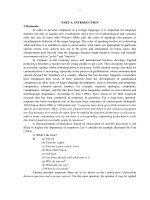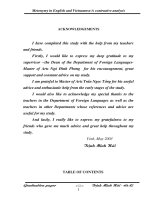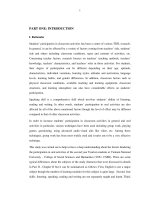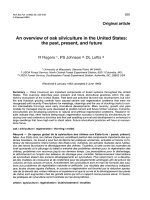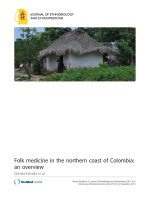An Overview into the Semantic of Questions in English and Vietnamese
Bạn đang xem bản rút gọn của tài liệu. Xem và tải ngay bản đầy đủ của tài liệu tại đây (148.67 KB, 21 trang )
Nguyen 1
An Overview into the Semantic of Questions in English and Vietnamese
Student: Nguyễn Thanh Thảo
4B07
Lecturer: Nguyễn Ngọc Vũ
University of Pedagogy
December 2010
Nguyen 2
Abstract
As early as the 18
th
century, studies on comparing and contrasting
linguistics became popular thanks to the emergence of new lands, new
communities, and new languages. Sine 1970s, comparing and contrasting
linguistics has been playing a more and more important role to meet the
rising demand for language learning to communicate and scientific
developments in the direction of multi-lingual research. In Vietnam, along
with economic growth, more and more people pick up learning a new
language so that they can have more advantages in running their business.
Nevertheless, most of language learners have the same obstacle in
comparing and contrasting their mother tongue with a foreign language,
which prevents them from acquiring a new language easily and effectively.
It is found that question is one of the most frequently used types of
sentences and English learners have encountered a lot of difficulties
practicing questions in speaking and learning. Therefore, this paper aims to
compare and contrast the differences and similarities of various types of
questions in English and Vietnamese and thus, suggest some application for
language teachers and learners.
Nguyễn Thanh Thảo
Nguyen 3
Lecturer: Nguyễn Ngọc Vũ
University of Pedagogy
December 2010
In conversations, questions are used to clarify and seek information. That’s why
questions are sometimes referred to as interrogative sentences because we ask for
something we are unclear about (wikipedia, 2010). However, in fact, asking doesn’t
mean inquiring for new information. We tend to use questions as a function for greeting
each other (Thiêm, 2004). For example, Vietnamese people may ask “anh đi đâu đó?”
when we meet our friends. It functions as a greeting instead of a request for information
about the place that person is heading to. Thus, questions can be defined as
sentences which are followed by a question mark at the end and used for seeking
information. However, there are some sentences in the form of questions but they
don’t require an answer. We often use those sentences for greeting purposes.
In terms of speaking purposes, there are 2 types of questions: Questions that
function as a request for information and questions used for a variety of speaking
purposes (Thiêm, 2004). This paper mainly focuses on the semantics of questions
that function as a request for information. The semantics refers to the close and
intense relationship between the form and the meaning of a sentence (Thiêm,
2004). Comparing and contrasting questions in terms of their semantics enable us
to point out the question framework, the devices and operators that contribute to
forming questions (Thiêm, 2004).
1. Types of questions in Vietnamese and English
a) Types of questions in Vietnamese
Nguyen 4
Basing on their semantics, Vietnamese linguists have classified two main
types of questions (Thiêm, 2004). They are alternative questions and questions
that offer no choice. First of all, let us have a look at alternative questions.
Alternative questions are those that offer options, which are signposts used for
marking the sphere of oscillation in the speaker’s consciousness (Thiêm, 2004).
Particularly, alternative questions require the respondent to answer by picking out
the information that is being sought. In Vietnamese, there are three main sub-types
of alternative questions. They are questions formed by “Là/ hay là”, questions
formed by “Có … không, phải không”, questions using model particle “à, ư, nhỉ,
nhé” (Thiêm, 2004).
Following are examples and features of each sub-type.
Alternative questions
• Questions with: là / hay là
à Tôi, hay anh đi mua đồ cho lớp mình?
à Ngày mai lớp mình kiểm tra toán hay văn?
à Bây giờ chúng mình đi ăn phở hay là về nhà làm bài tập?
à Sống hay là chết?
The options can be obviously mentioned in the questions: anh / tôi, toán /
văn, ăn phở/về nhà làm bài tập, sống / chết. In some cases, there can be a group
of choices, e.g. cả chị cả em; exclusion, e.g. không phải anh, không phải em,
không ăn phở, không làm bài tập; or turn-taking, e.g. học rồi ăn, tôi rồi đến lượt
bạn … (Thiêm, 2004).
The most important thing is that we should not present so many options or
objects at a time.
E.g. Mẹ nên nấu canh bầu hay canh bí, canh khổ qua, canh chua …?
Chúng ta cần tài liệu về Trung Quốc, hay là Việt Nam, Mỹ, Canada …?
Also, objects or options that do not belong to the same category or
reference should not be included in the question due to the fact that the form of the
question, though grammatically correct, goes against common sense and doesn’t
conform to its content.
E.g. Vietnamese people never say: “ Em nên mua máy tính hay nấu cơm?”
Nguyen 5
Neither do we say: “Sóng thần do động đất dưới đáy biển hay là suy thoái
kinh tế gây ra?”
• Questions with “có… không, … phải không, đã … chưa, …”
E.g.: Hôm nay thầy có dạy không?
Con có ăn cơm không?
Mẹ đã đi làm về chưa?
Em đã làm bài chưa?
Cô là cô giáo chủ nhiệm của lớp em phải không?
Đây là nhà anh ấy phải không?
As we can see from the above examples, questions of this type contain two
opposite clauses, in which the positive one normally stand at the front and the
negative one is often in the back (Thiêm, 2004). However, for questions like these:
Em có muốn ăn bánh mì không?
Chúng ta có tiếp tục dự án này không?
There is no distinction between two clauses, that is we cannot tell which one
is more positive. In this case, the particle không is put at the end of the question.
• Questions with particles and complementary groups
E.g.: Hôm nay con không đi học à?
Tên bạn là gì thế nhỉ?
There are some modal particles contributing to forming alternative
questions. They are: à, nhỉ, hả, nhé, ư, chứ, sao, nha, vậy, … (Thiêm, 2004). We
often find them at the end of the questions. These modal particles functions as the
intonation for ending a question.
E.g.: Bây giờ chúng ta bắt đầu nhé?
Cô ấy lại mất tiền nữa ư?
Hắn làm hỏng bữa tối thật chứ?
Nếu em có ở đây bây giờ thì vui lắm nhỉ?
Those questions using modal particles also functions as exclamative
sentences. Interestingly, alternative questions require answers while exclamative
sentences don’t.
Questions in which there is no options in the predicative
Questions of this type often contain question words or groups of question
words like gì, nào, ai, đâu, sao, bao giờ, như thế nào, ra sao, lúc nào …
There is no option in this type of questions; therefore, the answer
contains as much information as possible, concerning the question and the
possible contexts (Thiêm, 2004). For instance:
Ai là lớp trưởng của lớp 4B?
Bạn muốn gì?
Chừng nào khoá học này kết thúc?
Nguyen 6
Bài toán này giải như thế nào?
Vụ án này tình tiết ra sao?
Trường Đại học Sư Phạm ở đâu?
There is a wide variety of topics for questions of this type.
• Questions about people:
Ai vậy?
Ai đang ở đầu dây đó?
Ai là chủ công ty này?
Ai là lớp trưởng lớp 4B?
• Questions about things or objects:
Cái gì đây?
Cái gì ở trên bàn vậy?
Bạn cần gì?
Điều gì quan trọng nhất trong cuộc sống?
• Questions about manners, features, qualities:
Ngôi nhà này như thế nào?
Kết quả cuộc hành trình ra sao?
Toà tháp được xây bằng cách nào?
• Questions about position:
Nhà bếp ở đâu?
Cửa hàng điện ở chổ nào?
Ngươi là người nơi nào?
Em phải tìm anh ở chốn nào?
• Questions about time:
Bao giờ cho đến tháng ba?
Khi nào mẹ về nhà?
Buổi họp kết thúc vào lúc nào?
• Questions about causes
Tại sao lại như vậy?
Vì sao con khóc?
Anh nghỉ làm vì lí do gì?
• Questions about quantities
Táo bao nhiêu một kí?
Nhà em có mấy người?
Mấy giờ em tan học?
We should also notice that when asking about time, we can combine the
question word with a preposition to indicate the point of time (Thiêm, 2004).
E.g.: Từ lúc nào bà ấy mắc căn bệnh hiểm nghèo đó?
Câu chuyện diễn ra vào thời điểm nào?
b) Types of questions in English
In English, there are many ways to categorize and define questions. In
“Practical English Usage”, questions are classified into 4 main types (Swan,
2003):
